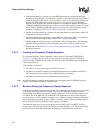
Intel® PXA255 Processor Developer’s Manual 3-9
Clocks and Power Manager
GPIO Reset does not reset the Memory Controller Configuration registers. This creates the
possibility that the contents of external memories may be preserved if the external memories are
properly configured before GPIO Reset is entered. To preserve SDRAM contents during a GPIO
Reset, software must correctly configure the Memory Control and the time spent in GPIO Reset
must be shorter than the SDRAM refresh interval. The amount of time spent in GPIO Reset
depends on the CPU’s mode before GPIO Reset. See Section 6, “Memory Controller” for details.
Refer to Table 2-6, “Pin & Signal Descriptions for the PXA255 Processor” for the states of all the
PXA255 processor pins during GPIO reset and other resets.
3.4.3.3 Completing GPIO Reset
GPIO Reset immediately reverts to Hardware Reset when the nRESET pin is asserted. Otherwise,
the completion sequence for GPIO Reset is:
1. The GPIO Reset Source is deasserted because the internal reset has propagated to the GPIO
Controller and its registers, which are set back to their reset states.
2. The nRESET_OUT pin is deasserted.
3. The normal boot-up sequence begins. All processor units except the Real Time Clock, parts of
the Clocks and Power Manager, and the Memory Controller return to their predefined reset
conditions. Software must examine the RCSR to determine the cause for the reset.
3.4.4 Run Mode
Run Mode is the processor’s normal operating mode. All power supplies are enabled and all
functionally enabled clocks are running. Run Mode is entered after any power mode, power
sequence, or reset completes its sequence. Run Mode is exited when any other power mode, power
sequence, or reset begins.
3.4.5 Turbo Mode
Turbo Mode allows the user to clock the processor core at a higher frequency during peak
processing requirements. It allows a synchronous switch in frequencies without disrupting the
Memory Controller, LCD Controller, or any peripheral.
3.4.5.1 Entering Turbo Mode
Turbo Mode is invoked when software sets the TURBO bit in the Clock Config (CCLKCFG)
Register (See Section 3.7.1). After software sets the TURBO bit, the CPU waits for all instructions
currently in the pipeline to complete. When the instructions are completed, the CPU resumes
operation at the higher Turbo Mode Frequency.
Software can set or clear other bits in the CCLKCFG in the same write that sets the TURBO bit.
The other bits in the register take precedence over Turbo Mode, so, if another bit is set, that mode’s
sequence is followed before the CPU enters Turbo Mode. When the CPU exits the other mode, it
enters either Run or Turbo Mode, based on the state of the CCLKCFG [TURBO] bit.
Do not confuse the CCLKCFG Register, which is in Coprocessor 14, with the CCCR (See
Section 3.6.1), which is in the processor’s Clocks and Power Manager.


















